January 13, 2017
Air Date: January 13, 2017
FULL SHOW
SEGMENTS
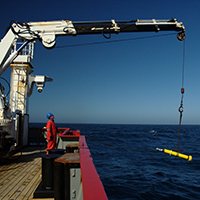
Yes, It’s Getting Hotter
View the page for this story
New analysis of sea surface temperatures validates the National Oceanic and Atmospheric Administration’s updated global warming record released in 2015. This confirmation rebuts allegations from some Republicans on Capitol Hill that NOAA manipulated the 2015 NOAA data, which shows continuing global warming as opposed to earlier NOAA research that had suggested a two-decade long warming pause. (09:04)
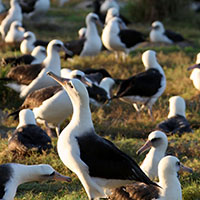
Beyond The Headlines
/ Peter DykstraView the page for this story
Continuing their conversation from last week, Peter Dykstra and host Steve Curwood look back at the year’s most prominent environmental feats and shortfalls, which include the Obama administration’s encounter with fake news, new chapters in the environmental justice movement and an unlikely city to turn to renewable energy for lighting up its famous nightlife. (05:08)
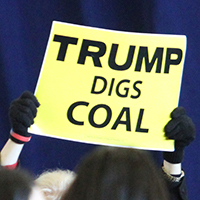
Coal Country Wants to Believe Trump
/ Reid FrazierView the page for this story
President-elect Donald Trump has promised to bring back coal miners jobs and reopen the mines, attracting broad support in Pennsylvania’s coal country. Allegheny Front reporter Reid Frazier interviewed miners and state lawmakers about their hopes and expectations under the new Presidency. (04:28)
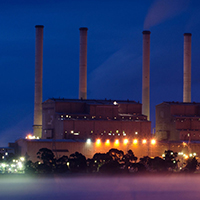
Dark Side of Obama's Climate Legacy: $$ For Overseas Coal Gas & Oil
View the page for this story
The federal Export-Import Bank finances overseas projects to help sell American goods. The bank gave coal, gas and oil projects nearly $34 billion worth of loans and guarantees during President Obama’s tenure. Investigative reporter Susanne Rust tells Host Steve Curwood the projects will emit about as much greenhouse gases as would be saved through Obama’s embattled Clean Power Plan. (09:16)

BirdNote: Whistling Birds
/ Michael SteinView the page for this story
Birds can squawk, trill, or chirp, and a few whistle. As Michael Stein points out, those are often the easiest ones for humans to imitate. (01:53)
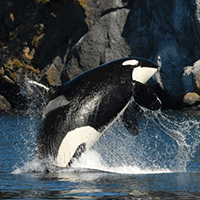
Missing Granny the Whale
View the page for this story
They called her “Granny”, the matriarch of an orca pod in Puget Sound. Ken Balcomb, founder of the Center for Whale Research, has studied Granny, officially named J2, for more than four decades. Granny might have been as old as 105 and she led her pod to find salmon, their major food source. She’s presumed dead as she has not been seen for over 3 months. Ken Balcomb tells host Steve Curwood, the J-pod, already impacted by rising toxicity in the ocean food chain and depleted salmon stocks, may now fragment. (16:28)
Show Credits and Funders
Show Transcript
HOST: Steve Curwood
GUESTS: Zeke Hausfather, Susanne Rust, Ken Balcomb
REPORTERS: Peter Dykstra, Reid Frazier
[THEME]
CURWOOD: From Public Radio International, this is Living on Earth.
[THEME]
CURWOOD: I'm Steve Curwood. Facts versus political fancy...how careful scientific language has been spun to give comfort to climate denialists.
HAUFATHER: People interpret, "this is uncertain" as "we know nothing". Scientists have said multiple times that we're 95 percent certain that the majority of warming in recent years is due to humans. If 19 out of 20 doctors that you talked to said that you had a tumor, you probably would want to do something about that.
CURWOOD: Also, saying farewell to Granny, the oldest known killer whale and the matriarch who led her pod.
BALCOMB: Females, like female humans, have a menopause. At about age 40, they stop reproducing, but they'll still have a long post-reproductive life, babysitting, leading, teaching the other whales. At least, she was born before 1941 and probably 1911.
CURWOOD: We’ll have those stories and more this week, on Living on Earth. Stick around.
[NEWSBREAK MUSIC: Boards Of Canada “Zoetrope” from “In A Beautiful Place Out In The Country” (Warp Records 2000)]
[THEME]
Yes, It’s Getting Hotter
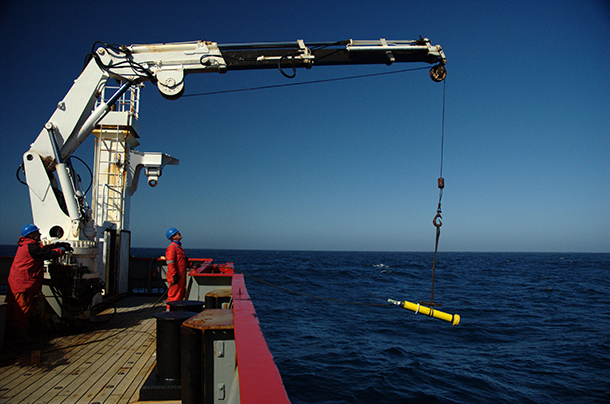
An Argo float being raised out of the Bellingshausen Sea. (Photo: fruchtzwerg's world, Flickr CC BY-NC-ND 2.0)
CURWOOD: From the Jennifer and Ted Stanley Studios at the University of Massachusetts Boston and PRI, this is Living on Earth. I’m Steve Curwood.
There’s been snow on the ground in all but one of the 50 United States in recent days, highlighting climate volatility but also encouraging global warming skeptics who don’t, or won’t, understand the science. Skeptics are also heartened by the so-called “global warming pause”, a period between 1979 and 2014 when research based on sea surface data made it appear that average global temperatures were not rising, but in 2015, the National Oceanic and Atmospheric Administration updated their research with new data that does show a steady rise in global temperatures. This outraged some politicians who claimed that the numbers were recalibrated to please climate action proponents on Capitol Hill. Now, another study has independently corroborated NOAA’s new results. Zeke Hausfather, a research scientist at Berkeley Earth in California was one of the lead authors of that study. Welcome to Living on Earth.
HAUSFATHER: Thank you, Steve.
CURWOOD: So, the updated sea surface temperatures...why was his controversial that scientists are always correcting their data when they get more information?
HAUSFATHER: So, in 2015 NOAA published a paper in "Science" where they released a new version of their sea surface temperature records. They updated it from version 3 to version 4. Now, this new version showed a lot more warming than their old version. It roughly doubled the amount of warming reported since 1998. While this doesn't make that big a difference in an understanding of long-term warming, it makes a big difference in this so-called pause or hiatus period in recent years a lot of folks been talking about. And in fact, in this new NOAA record, it's hard to see any slowdown or pause in warming at all in recent years. So, it was controversial mainly because of its implications. The new data showed no slowdown in warming, that ruffled a lot of feathers particularly in Capitol Hill and led to a number of Congressmen, including the head of the House Science and Technology Committee, to accuse NOAA scientists of cooking the proverbial books and even demand access to all the scientists' emails.
CURWOOD: So, what prompted you and your organization to replicate the 2015 research that was conducted by NOAA?
HAUSFATHER: We, from a scientific standpoint wanted to figure out what exactly was going on in the last 15 years to the Earth's climate and particularly the Earth's oceans, which are two-thirds of the planet, and there's pretty big disagreements now between the old NOAA record which showed a lot less warming, the new record which shows a lot more warming, and the record from the UK Hadley Centre, which is one of most commonly used global temperature records, which is about halfway between the old and new NOAA records.
CURWOOD: Talk to me about the instruments that have been used before. What was the Hadley Centre of the Met office, how were they getting their data, how was NOAA getting its data earlier?
HAUSFATHER: Sure, so the way we measure ocean temperatures has changed a lot in the last two decades. Until the 1990s, pretty much all of our measurements came from ships. In the distant past, it was by throwing buckets over the side of ships, pulling them up, and sticking a thermometer in those buckets. More recently it's in ship engine rooms and and engine intake valves, where they pull in water through the hold to cool the engine; they stick a thermometer in it. But starting in the early 1990s, governments around the world started investing a lot of money in modern, high-quality ocean monitoring systems, initially, with buoys but also with satellites.
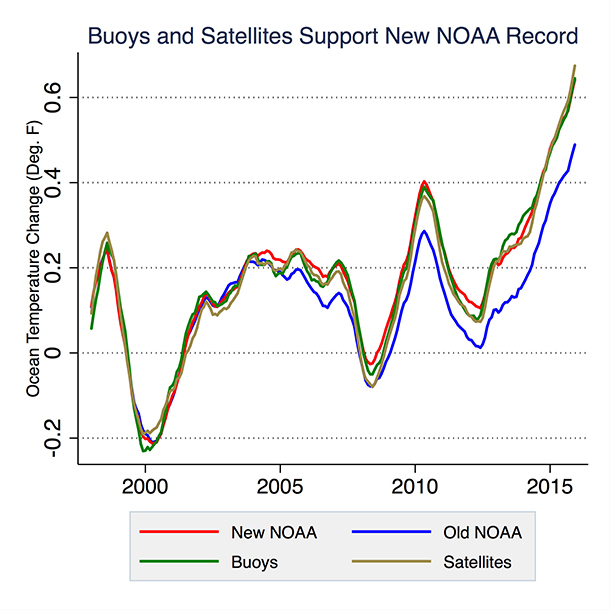
The records taken with modern temperature data-collection instruments like buoys and satellites agree nearly perfectly with the new NOAA record. (Photo: courtesy of Zeke Hausfather)
CURWOOD: So, what were the objectives then precisely of your recently published study?
HAUSFATHER: So, both the NOAA record and the record by the UK's Hadley Center are what we call composite temperature records. They try to take data from a lot of different types of instruments like ships and buoys and smush them all together into a single, long-term record. Now, the problem with that is, whenever you combine different types of instruments, they measure temperature differently, and there's some judgment calls needed on how you handle the transition from one to another. Our insight, and what made our study important is, we said, “Well, what if we don't try to combine instruments? What if we use data just from one type of instrument? And it turns out that in the last two decades we've had an unprecedented amount of new Earth observation data that we’ve never had before, a lot of it which isn't being used by current monitoring groups.
So what we did is, we took data just from ocean buoys. We took data just from satellite radiometers, which are essentially like infrared cameras in space. We took data just from Argo floats, which are these awesome little robots that float around the ocean and dive deep down and come back up every few days and then send their readings up to the satellites automatically. And the nice thing about these, what we call instrumentally homogenous records, is that they don't require any adjustments for switching from instrument with another, and it turns out that all three of those records - the buoy record, the Argo record, and the satellite record - agree almost perfectly with the new NOAA temperature record. They show a strong cooling bias, or lower trend, in the old NOAA and a more modest but still significant cool bias in the Hadley Centre record.
CURWOOD: So, what you're telling me, then, is, if you just look at actual data from the more modern instruments, you still come up with results are really consistent with what NOAA has found in its most recent paper.
HAUSFATHER: Correct. And in fact, what seems to be going on seems to be that there is some changes to the global shipping fleets that are affecting temperatures in recent years. We have bigger ships with deeper holds. You have all these giant cargo ships now that you didn't necessarily have as many of 20 years ago, and, if the hold of the ship is deeper, for example, you're measuring the ocean water at a deeper depth, that ocean water is going to be a bit colder. And so things like that will affect your measurements.
You know, the problem with ships is every ship is different, and all the individual factors of that ship - its hull depth, its speed - are going to affect its measurements. Whereas, something like buoys or Argo floats or satellites - every buoy is the same. They're specifically designed to measure climate data. They all have the same type of measurement system. You're not going to have any uncertainty between buoys that you have, say, between ships. Now, for the deep past and before 1990, we're stuck with ships because that's all we had. But, for the modern period, we have the luxury of having more high-tech, up-to-date measurement systems.
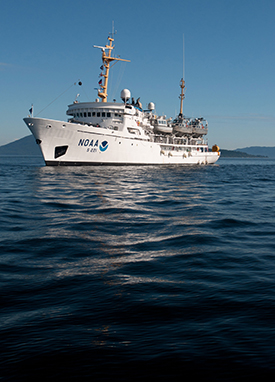
Zeke explained that bucket sampling by ships and measuring ship intakes are a more archaic and imprecise means of collecting ocean data when compared to more modern devices like Argo floats and satellite radiometers. (Photo: Damian Manda, Flickr CC BY-NC 2.0)
CURWOOD: So, if you were to take your data and extrapolate it in terms of long-term warming, how much trouble are we in now as a civilization?
HAUSFATHER: It depends a lot on how much greenhouse gases we emit in the future. In a business-as-usual world where we do nothing to cut emissions, we could see somewhere around four degrees Centigrade, close to nine degrees Fahrenheit warming globally. To put that in perspective, the difference between the middle of the last Ice Age and today was only about nine degrees Fahrenheit globally, so we're talking about potentially very large disruptions to ecosystems, to food production, factors like sea level rise, ocean acidification, that all have the potential to seriously disrupt future society.
Now, that's in the business as usual world. If we take aggressive action to reduce emissions and the global agreement between pretty much between every nation in the world at Paris last year was a good first step down this path, we could limit warming by 2100 to only two degrees Centigrade, or about just under four degrees Fahrenheit, which would've some effects, but those would be much smaller than in a world we do nothing.
CURWOOD: Why do you think some Republican lawmakers were so unwilling to accept the revised NOAA paper?
HAUSFATHER: So, part of the problem is that climate change in general has become a political hot button issue, and, unfortunately, it means that the way that the people interpret the science is shaped by their preconceptions and by what they think may be the implications of that science. And I think a lot of people who wanted to dismiss or sort of downgrade the importance of climate change had been focusing a lot on this apparent pause in recent temperatures, and when NOAA revised the records to show that, wait a minute, a lot of this apparent pause was due to an error in how we measure ocean temperatures, that wasn't very palatable to them, and so I think it wasn't so much because they deeply understood the science involved and thought NOAA had made some sort of mistake. It's that they didn't like the implications of their results, and, in general, the way science works is, when you disagree with the result you don't go after the scientists' emails, you ask other scientists to replicate it. And what Congress should have done is ask the National Academy of Sciences, which is an institution set up by Abraham Lincoln to advise Congress on scientific matters, to look into this if they think that a government agency like NOAA is not doing its job properly.
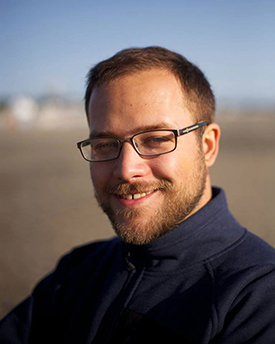
Zeke Hausfather is a research scientist with Berkeley Earth, a non-profit dedicated to reanalyzing the Earth’s surface temperature record. (Photo: courtesy of Zeke Hausfather)
CURWOOD: Scientific approach generally says that sooner or later what we think is true today won't be true in the future, that we'll find a new information that better informs us. How do you take that fact of scientific life and blend that with the policy world that wants a decision, that wants clarity?
HAUSFATHER: It's a challenge. Science is all about uncertainty. The only certain things in life or death and taxes as we like to say, but to be honest, policymakers aren't very certain about things either when they're deciding the implications of tax policy or the effects of the change in educational policy. The problem in a lot of cases is that people interpret, “This is uncertain,” as “We know nothing”. Scientists have said multiple times that we're 95 percent certain that the majority of warming in recent years is due to humans. Ninety-five percent is a pretty good number. If 19 out of 20 doctors you talked said that you had a tumor, you probably would want to do something about that, even if that one out of 20 was less sure.
CURWOOD: Zeke Hausfather is a research scientist at Berkeley Earth. Thanks so much for taking time with us today.
HAUSFATHER: Thanks, Steve.
Related links:
- Zeke’s research and video explainer
- The 2015 NOAA study
- Mashable.com: Background on the controversy between NOAA and the GOP
- Zeke Hausfather bio
Beyond The Headlines
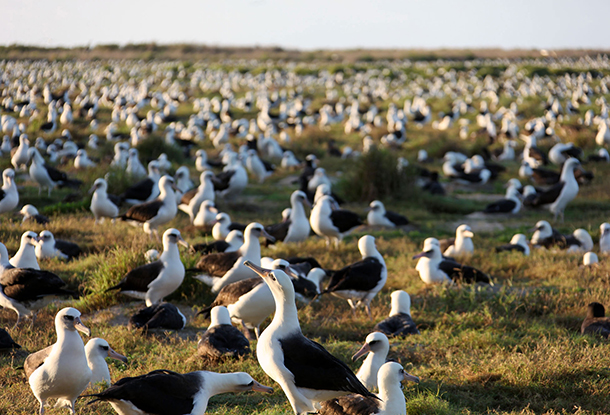
A flock of Laysan albatross gather on a hill in the Papahanaumokuakea Marine National Monument, the world’s largest ecologically protected area, which President Obama set aside in 2016. (Photo: Andy Collins / NOAA Office of National Marine Sanctuaries, Flickr, CC BY-NC 2.0)
CURWOOD: And now we’ll check in with the world beyond the headlines with Peter Dykstra of Environmental Health News. That’s EHN.org, and DailyClimate.org. From his perch in Conyers, Georgia, he’s continuing his look back over some of the environmental news during the Obama years. Hi, Peter.
DYKSTRA: Hi, Steve. I want to start with an obscure item from 2010 that some folks may not remember, or had ever heard about in the first place. The Obama Administration had assembled a task force to look at the management of the nation’s waterways. A columnist for ESPN.com wrote a piece suggesting that this was a first step toward banning all fishing, by everyone, everywhere.
CURWOOD: Huh, all fishing everywhere. Wouldn’t that have been about the dumbest political move, ever?
DYKSTRA: Yeah, it made no sense that Obama would even consider this – a man two years away from his re-election bid, angering 50 million US recreational fishermen – and commercial and rec fishing are worth about $40 billion a year each to an economy that at that time was just beginning to bounce back from crisis. Logic strongly suggests, this couldn’t possibly have been true.
CURWOOD: And as a matter of fact, it wasn’t true. So much for logic.
DYKSTRA: But the fake news about Obama’s fishing ...Wait...Let’s not call it “fake news”. “Lie: or “Hoax” would be a better fit. The fishing ban report went viral, clogging anti-Obama websites and talkshows with headlines like “Obama’s latest assault on freedom”. The Administration was forced to deny something that never really existed. But before he left office, Obama left a strong mark on oceans’ policy by joining the growing movement to create marine reserves.
CURWOOD: Oh yeah, sort of salt water versions of Yellowstone and Yosemite and Glacier and the Grand Canyon, huh?
DYKSTRA: Exactly. Chile, the UK, Australia, New Zealand, Palau and others have been on a spree of setting aside ecologically significant areas in the Pacific and also in the Indian Ocean, to protect them from commercial exploitation. Obama set aside a huge area near the Hawaiian Islands, following a trend started by President George W. Bush, whose legacy of marine reserves was one of the environmental high points of his time in office.
CURWOOD: And of course, there’s the big international move to protect the Ross Sea in Antarctica this past year.
DYKSTRA: That’s an area that’s twice the size of Texas. Twenty-four nations have agreed to protect what’s been called “the least-altered marine ecosystem on Earth”.
CURWOOD: But you know, Peter, it’s not just declaring these areas protected. Really, it’s a daunting task to make sure these vast stretches of the ocean aren’t being overfished or mined, no matter who says, “They’re protected.”
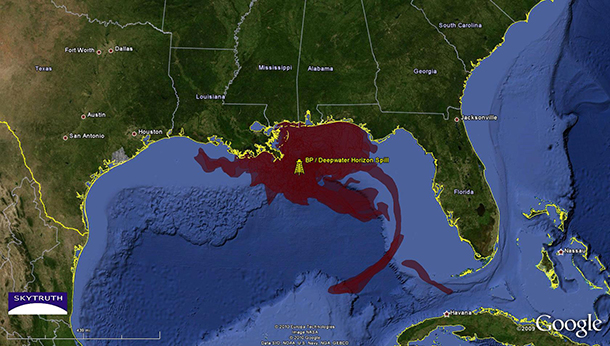
A satellite graphic of the 2010 BP Deepwater Horizon oil spill made by Skytruth, a nonprofit group working to use satellites imagery and drones to police the oceans. (Photo: John Amos, Flickr, CC BY-NC-SA 2.0)
DYKSTRA: Of course, and there’s even some good news there. Satellite monitoring for potentially illegal fishing is beginning to have an impact. A little nonprofit called SkyTruth has partnered with Google and other NGOs like Oceana and Pew to be the oceans “eyes in the sky”. Use of satellites and drones to police illegal logging, water theft, oil spills and much more has also taken hold in recent years. Next, I’ve got a little mixed news from the Obama years.
CURWOOD: Oh, let’s hear it.
DYKSTRA: Environmental justice has been a cause and a concept since the early 1980s, but it’s always seemed to have a hard time receiving more than good intentions and lip service from official Washington. But two outrages toward the end of the Obama era helped rekindle the movement. One was how local, state and federal officials knowingly let the people of Flint, Michigan, drink lead-tainted water, and the other one was the violent official response to Native American-led protests of the Dakota Access Pipeline.
CURWOOD: Yeah, well the Dakota Access pipeline’s stopped – for now – and there have been some criminal indictments in Flint.
DYKSTRA: But the water’s still not right in that struggling city, and the focus on Flint has led to the discovery of literally thousands of other cases of lead in drinking water nationwide. At year’s end the Centers for Disease Control said they were considering making the standards for lead exposure tighter. Let’s move on to what’s happening in US cities.
CURWOOD: Yeah, there’s a lot of expectations that cities are going to step up to play a bigger role in sustainability.
DYKSTRA: Which would be particularly important because so many states are strapped for cash, and have cut environmental programs. They’ve even cut parks. And don’t get me started on what lies ahead on the federal level.
CURWOOD: No, I won’t, we’ve only got a couple of minutes, Peter.
DYKSTRA: Well, one example. Boston’s using technology to find methane leaks from aging infrastructure beneath its streets. Cities everywhere are warming to the idea of bike and walking trails, like the Beltline not too far from me here in Atlanta. But my favorite urban sustainability thing is my favorite because it comes from a city you would not expect.

Many people from across the country came to stand in solidarity with the Standing Rock Sioux Tribe’s struggle against the construction of the Dakota Access Pipeline in North Dakota (Photo: Joe Brusky, Flickr CC BY-NC 2.0)
CURWOOD: Which would be?
DYKSTRA: Vegas, baby, Vegas! The Las Vegas city government inked a deal in December where every bit of municipal electricity will come from renewables: streetlights, public buildings, and more.
CURWOOD: But not all those bright lights and big fountains on the Vegas strip, right?
DYKSTRA: No, but it’s a start, and it’s a trend, and what happens in Vegas...
CURWOOD: No need to read back their tourism slogan, please.
DYKSTRA: OK. Let me give you one final set of numbers on the Obama Era. In the President’s first year, his party controlled both the House of Representatives and the Senate. That year, the League of Conservation Voters scorecard gave 11 Senators a zero rating for their environmental votes, and they gave 51 House members a zero. But in LCV’s most recent scorecard, covering the year 2015, the Republicans had taken control of both houses, and the number of zero-rated Senators nearly tripled from 11 to 32, while the number of environmental zeros in the House exactly doubled, from 51 to 102.

The Las Vegas city government announced in December that municipal electricity would come entirely from renewable energy (Photo: VanessaC, Flickr CC BY-NC-ND 2.0)
CURWOOD: Hmmm, a possible sign of things to come. Peter Dykstra is with Environmental Health News, that's EHN.org and DailyClimate.org. Thanks, Peter. We’ll talk to you again soon.
DYKSTRA: All right, Steve, thanks a lot. We’ll talk to you again soon.
CURWOOD: And there’s more on these stories, as well as last week’s, on our website LOE.org.
Related links:
- NOAA commercial fisheries statistics
- Deadspin: “ESPN.com Helps Launch False ‘Obama Wants to Ban Fishing’ Rumor”
- UN.org: “More than five percent of world’s oceans now protected”
- National Geographic: About the Ross Sea marine reserve, the world’s largest
- National Geographic: SkyTruth’s Satellites
- Scientific American: “CDC Considers Lowering Threshold Level for Lead Exposure”
- Quartz: “Las Vegas’ city government is now powered by 100% renewable energy, and more cities will follow”
- The League of Conservation Voters
[MUSIC: Tim Gartland, “I Come When You Call” on If You Want a Good Woman, Taste Good Music]
CURWOOD: Coming up...the darker side of President Obama’s climate legacy. Stay tuned to Living on Earth.
ANNOUNCER: Support for Living on Earth comes from the Gordon and Betty Moore Foundation, and from a friend of Sailors for the Sea, working with boaters to restore ocean health.
[CUTAWAY MUSIC: Eileen Ivers & Immigrant Soul on “Parting Of Friends (air)” on Eileen Ivers & Immigrant Soul, traditional Irish/arr.Ivers, Aharon, Musical Bridge/Koch Records]
Coal Country Wants to Believe Trump
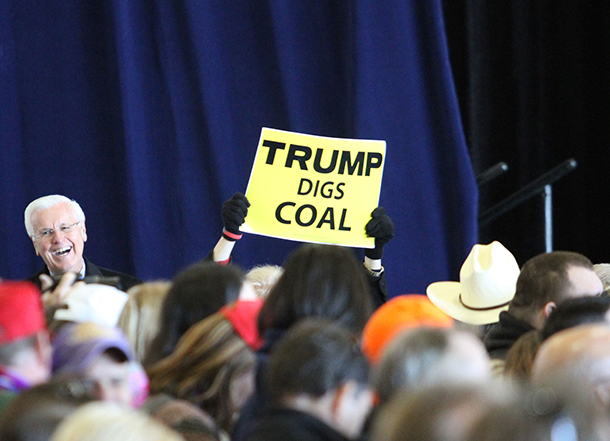
Coal miners made up a consistent interest group across the country at the President-elect’s rallies. (Photo: Tammy Anthony Baker, Wikimedia Commons CC BY 2.0)
CURWOOD: It’s Living on Earth, I’m Steve Curwood. One of the promises Donald Trump made on the campaign trail was to put the coal miners back to work and get the mines open. The message resonated in Pennsylvania’s coal country and helped win the region for the President-elect. Now folks are watching to see if he’ll keep his promise. As the Allegheny Front’s Reid Frazier reports, many of these voters don't expect miracles, but they do want Mr. Trump to put coal first.
FRAZIER: Stand outside a supermarket in Greene County in the southwestern corner of the state, and ask people what they want from the incoming president. You’ll hear this, a lot...
COURTWRIGHT: A lot of the coal miners are out of work, and their families are in need of work, as well as the construction aspect. I feel that there's a lot of people out there without jobs, and this time of the year they need jobs.
STROPE: And I just hope for better change within next four years for the coal miners.
KNIGHT: I would like to see more jobs, and less imports. I am definitely against imports.
FRAZIER: Dean Courtwright, Alissa Strope, and Kent Knight all want some version of the same thing - a return of industrial jobs like coal-mining to this part of the state. Greene County has lost a third of its jobs in coal mining, its largest industry, over the last four years. Donald Trump, who’s promised to slash environmental regulations on coal won the county by 40 points. So, now what? What do the voters who put Trump in the White House want?
In a word, jobs. It’s been over a year since the coal mine Dave Hathaway worked in closed. He spent most of 2016 sending out resumes, looking for work. The search gained urgency when his son Deacon was born in August.
[BABY BREATHING]
HATHAWAY: I like it when he gets milk drunk. He just passes back out. Little coma.
FRAZIER: Hathaway’s union, the United Mineworkers of America, traditionally supports Democrats. But these last two election cycles, in 2012 and 2016, it hasn’t endorsed any presidential candidate. In November Hathaway gave Trump his vote.
HATHAWAY: I voted for Trump. I mean, a coal miner would be stupid not to.
FRAZIER: Hathaway just got hired at a nearby mine. He thinks the election of Donald Trump means he’ll have a better shot at keeping this job, even though he didn’t really like a lot of the things Trump had to say during the campaign.
HATHAWAY: He is a wacko. I mean he's never gonna stop bein' a wacko, you know what I mean? But I mean the things he did say, the good stuff, was good for the coal mining community. But we'll see what happens.
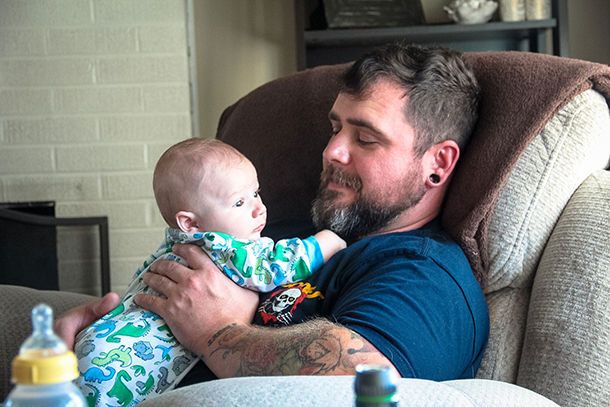
The coal mine that Dave Hathaway of Waynesburg, Pennsylvania worked at closed about a year ago. He voted for Donald Trump in the Presidential election. (Photo: Reid Frazier)
FRAZIER: Tom Crooks witnessed the decline in coal firsthand. He’s a vice president at RG Johnson, a construction firm that builds mine shafts.
CROOKS: Two years ago this week we had 145 employees, and right now we have 22.
FRAZIER: Crooks doesn’t use the phrase "war on coal", but he does think federal regulations mounted by Obama’s EPA have weighed down his industry, regulations like the Clean Power Plan, which curbs greenhouse gas emissions from coal fired power plants. Crooks wants fewer regulations,\ and more government research into making coal as clean as possible.
CROOKS: And really what's happened over last eight years is, the smart people stopped working on coal, in part because of the way the federal government and the state governments looked at us. We just want them to start looking to coal as an option. That’s all.
FRAZIER: But wiping out regulations probably won’t bring all the coal mining jobs back. That’s because a big cause for coal’s demise is the low price of natural gas. Some of it coming from gas wells nearby.
Blair Zimmerman is Democratic Greene County commissioner and former coal miner. He supported Hillary Clinton, but he wished the Obama administration had spent more time helping coal-dependent communities transition their economies.
ZIMMERMAN: No one's knocked on my door and saying, “Hey what can we do to bring back manufacturing? How can we help you help yourselves?” That's my beef. Coal miners can do anything. They can transition to whatever.
FRAZIER: Instead of a return to what once was, Zimmerman wants Trump to help his community prepare for what comes next. I’m Reid Frazier.
CURWOOD: Reid reports for the Pennsylvania program, The Allegheny Front.
Related links:
- This story on the Allegheny Front’s website
- Donald Trump speaking at rally about coal endorsement
[MUSIC: John Fahey, “Let Go” on Let Go, Baden Powell/Terrapin Music, Varrick CD]
Dark Side of Obama's Climate Legacy: $$ For Overseas Coal Gas & Oil
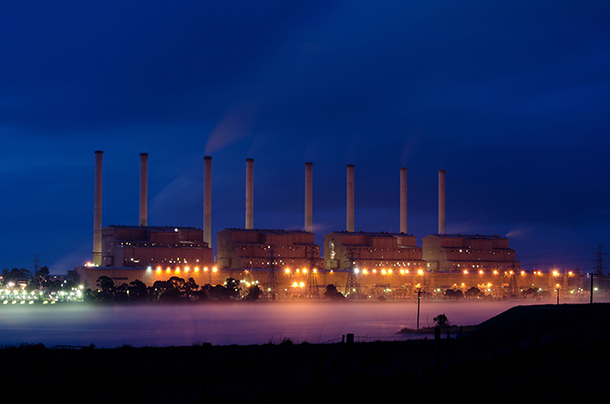
The fossil fuel projects funded by the Export-Import Bank include coal-fired power plants (Photo: Monash University, Flickr CC BY-NC 2.0)
CURWOOD: Now, the incoming Republican Administration may seek to boost domestic coal production, but it appears the outgoing Democratic one did plenty to boost coal and other fossil fuel energy projects around the globe. Investigative reporting by a joint team from the Guardian and the Columbia University School of Journalism reveals that the Export-Import Bank financed around 75 coal fired power plants and other fossil fuel energy projects in foreign countries. And these foreign fossil fuel plants are projected to release just about as many tons of global-warming gasses as the Obama Clean Power Plan would have saved. Susanne Rust is the director of Columbia’s Energy and Environment Reporting Project and the senior investigator on this story. Susanne, welcome to Living on Earth.
RUST: Thank you for having me.
CURWOOD: So, tell me, how does this all begin? What prompted you and your team to look into the Obama administration's funding of fossil fuel energy projects abroad?
RUST: So, we are a small team here at Columbia. Every year, I take four recent graduates from the program. They work as investigative reporters, and we had finished a year looking at ExxonMobil and what they had known about climate change during the 1990s and how they incorporated it into their business operations, and we came across a story in The Nation magazine that looked at a project that ExxonMobil had sponsored in Papua New Guinea. That project had led to a landslide. It was an environmental disaster. And it was funded by this obscure Great Depression era bank which operates within the Executive Branch, the Export-Import Bank. And so we decided to see, well, if they're doing this project, what else did they decide to do? And apparently, they sponsored quite a lot of fossil projects.
CURWOOD: Yeah, the Export-Import Bank has been the crosshairs of concern of environmental activists for years. What does this bank do, and what effect do you think it has on the projects that it finances vis-à-vis the American economy?
RUST: So, what the bank does is, it provides loans, guarantees, working capital and insurance for companies to promote their wares overseas. Right? To export engineering services or could be carpet cleaning. It could be anything, just to get American work overseas. So, they will say they're very important, that they provide this sort of export financing that these companies wouldn't be able to find without them. They are providing a level playing ground because I think there are something like between 50 and 70 other export credit agencies from different countries around the world that support their companies, jobs again, overseas. So they say they have a big effect here, but they actually, if you look at the overall economy, support less than 2 percent of American exports overseas.
CURWOOD: Well, I think the defenders of the EXIM bank would say, the power of it is in guarantees, and sometimes for massive projects, say, like a power plant.
RUST: They do say that, but then again we have a representative from the White House who says that if the Export-Import Bank had not sponsored these projects they probably would've been done anyway. So, yes, they say one thing, but they also say another.
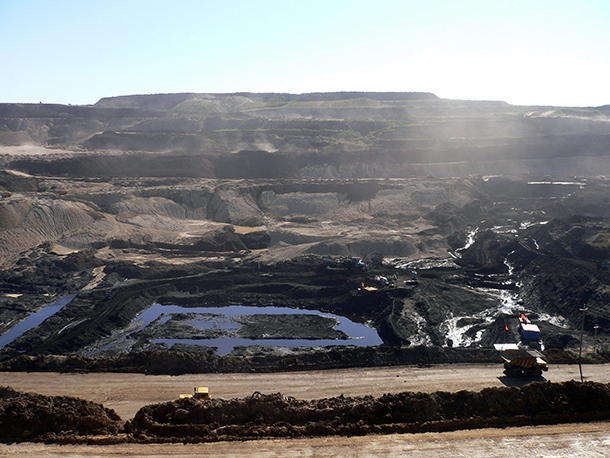
The projects funded by the Export-Import Bank during the Obama Administration would cancel out the greenhouse gas emissions projected to be averted through Obama’s Clean Power Plan. That’s not including the greenhouse gas emissions associated with mining, smelting, and other carbon-intensive industries funded by the bank. (Photo: Herry Lawford, Flickr CC BY 2.0)
CURWOOD: What kind of cash are we talking about, in terms of fossil fuel development, has the EXIM bank been able to promote?
RUST: We looked at 70 fossil fuel projects that have been financed by the bank over the past eight years which totaled $34 billion. The largest loan that we looked at went to a refinery petrochemical complex in Saudi Arabia and that loan was for almost five billion. We also looked at two coal plants, one in South Africa, one in India. These are two of the largest coal plants on the planet. We also looked at liquid natural gas ports and processing centers, two of which are actually within the Great Barrier Reef on Curtis Island in Australia. So, quite a menagerie of fossil fuel projects dispersed across the planet.
RUST: So, how much more greenhouse gas pollution are we talking about that we could attribute these projects that the EXIM bank supported during the Obama administration?
CURWOOD: So, again, using bank data, we calculated 164 million metric tons coming from these 70 fossil fuel projects.
RUST: 164 million metric tons of CO2. Over the lifetimes of these projects or every year?
CURWOOD: Every year. That's an annual amount.
RUST: And how would that compare to the aspiration of the President's Clean Power Plan?
CURWOOD: So, they almost match pound for pound. The Energy Information Administration put together a calculation for what the clean power plan would do over the next 15 years if it were to be enacted today, and it would save the atmosphere 2.5 billion metric tons of carbon dioxide over those 15 years. If you do the same thing for the 70 fossil fuel projects, you get about 2.4 billion, so it basically cancels that out.
CURWOOD: Tell me about the financing of these fossil fuel projects in the Obama administration. What was done, say, over the, what, maybe six years they were able to make these loans, and how does that compare to previous administrations?
RUST: So, that was one of the most striking aspects of this investigation. Obama has been very clear about his concern about climate change, but when we went through the data, we actually discovered that in the six-and-a-half years that the bank was fully functioning, they refinanced three times more than the George W. Bush administration had done within the eight years the Export-Import Bank was operating under his administration. So that was really striking to us and very surprising. We also found that if you added up the financing that was done under Ronald Reagan, George H.W. Bush, and Bill Clinton, again, the financing that was done in the six-and-a-half years that the bank was viable under Obama is more than twice the financing that was done under those three presidents combined.
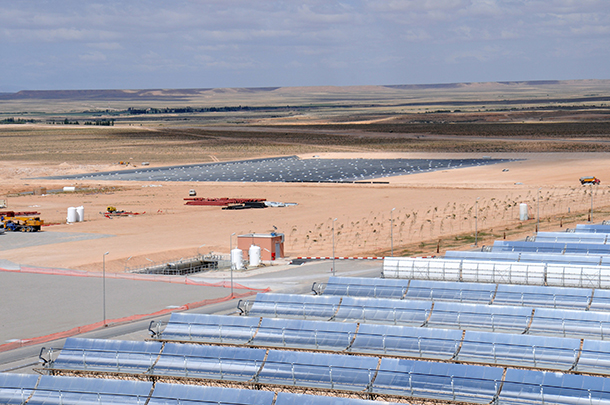
The Export-Import Bank provided about $2 billion of funding to renewable energy projects overseas during the same time period that it funded $34 billion in fossil fuel energy projects. (Photo: Dana Smillie / World Bank, Flickr CC BY-NC-ND 2.0)
CURWOOD: How do you think this happened? Do you think that the Obama White House just wasn't watching the store?
RUST: I think it's complicated. I think Obama came in at a time when the economy was floundering, right after the 2008 debacle, and his administration was looking for ways to promote and stimulate job growth. And in 2010, the State of Union, he promised that he would double exports over the next five years, and the Export-Import Bank, being the unique agency that focuses on exports, took that seriously and went around trying to figure out how they could increase their export business. And according to their spokesperson, fossil fuels, extractive industries were the place to be putting their money at that point in time.
CURWOOD: Now, to what extent does the Export-Import Bank support renewable energy projects? How much money has gone into that?
RUST: They have, again, since 2009 when President Obama stepped into office, they've been just shy of $2 billion dollars that have gone into renewable energy projects overseas. The bank, I believe it was in 2008, was required to put 10 percent of their budget into renewables; however, they say that all of the exports in renewables leaving the country couldn't meet 10 percent of their budget, so they're doing what they can.
CURWOOD: Now, alongside the Export-Import Bank is something called the Overseas Private Investment Corporation, which is OPIC, it is called. It's like EXIM. To what extent did you looked into that agency's financing?
RUST: We did not look much into OPIC, and I can't remember the year right now. It was 2004 or 2005. The Export-Import Bank and OPIC were sued by a handful of NGOs who were concerned, again, about this sort of very same topic about the amount of greenhouse gases that were being emitted overseas with US financing and that it was actually violating US law in doing so, that it could possibly endanger us by putting these greenhouse gases out there. As a result, OPIC, not the Export-Import Bank, promised to reduce their portfolio of fossil fuels, and they did. So, they actually finance very little overseas fossil fuel projects now.
CURWOOD: After the environmental advocates sued OPIC and the EXIM Bank, you say that OPIC reduced its fossil fuel portfolio. Why didn't the EXIM bank do the same?
RUST: It's unclear. That's the story we're working on right now as a matter of fact. So, I'll give you that answer when I get it.
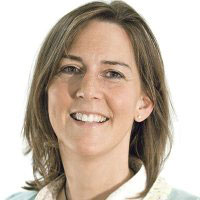
Susanne Rust teaches at the Columbia School of Journalism and led the investigative reporting project on the Export-Import Bank’s funding of fossil fuel projects. (Photo: Center for Investigative Reporting)
CURWOOD: Talk to me about the partisan divide, when it comes to the EXIM bank. To what extent have the Republicans supported this, to what extent did Democrats support this?
RUST: Well, it is interesting. So, there's actually quite a bit of news about the Export-Import Bank, but generally from the side of Republican disdain or dislike for the bank, they see it as a perfect example of government stepping in and picking winners and losers. You know, it's corporate cronyism, corporate welfare. It's been universally embraced by Democrats, and so these findings, I think, are particularly interesting because they sort of violate this environmental platform that Democrats have embraced.
CURWOOD: Susanne Rust is the Director and Senior Reporter at the Columbia University School of Journalism Energy and Environmental reporting project. Thanks, Susanne, for taking the time with us, and I look forward to your next update.
RUST: Thank you. It was great being with you.
Related links:
- Guardian: “How Obama’s climate change legacy is weakened by US investment in dirty fuel”
- Guardian: “Obama’s dirty secret: the fossil fuel projects the US littered around the world”
- Export-Import Bank of the United States
- The Energy and Environment Reporting Project at the Columbia Journalism School
- About investigative reporter Susanne Rust
BirdNote: Whistling Birds
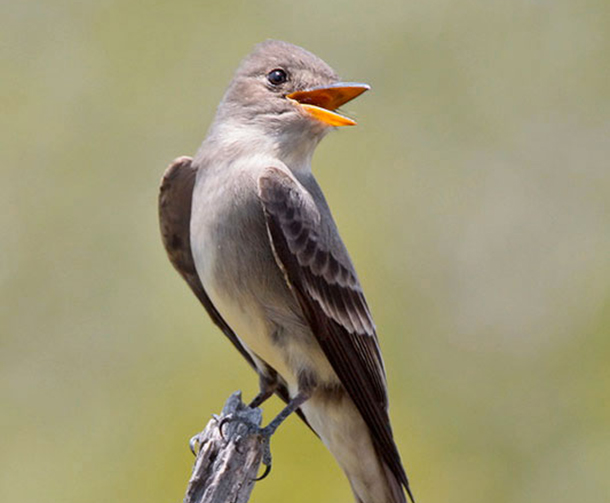
Eastern-wood Pewee (Photo: Joanne Kamo)
[MUSIC - BIRDNOTE® THEME]
CURWOOD: “Whistle and I’ll come to you” may be the title of a famous ghost story by British author MR James but usually whistling is a cheerful sound, and catchy, as Michael Stein tells us in today’s BirdNote®.
http://birdnote.org/show/birds-whistle
BirdNote®
Birds That Whistle
[Olive-sided Flycatcher, http://macaulaylibrary.org/audio/195787]
STEIN: Some of the most familiar and easy to remember birdsongs are those that sound like they could have been whistled by a human. Their quality and simplicity remind us of the sounds we can make, even with our modest human whistling apparatus.
The Olive-sided Flycatcher has one of the most distinctive and catchy songs on the continent —
[http://macaulaylibrary.org/audio/195787].
— and many birders learn early on to pick out its sharply inflected three-note song, and to imitate it [Narrator’s imitation of whistle].
The Eastern Pewee has a catchy tune too…
(http://macaulaylibrary.org/audio/191222)
…pretty much whistling out its name, pee-a-wee. A bit harder to imitate though -
[Narrator imitates.].
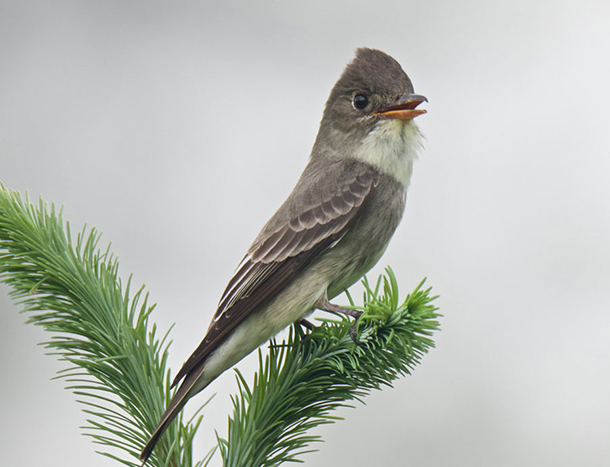
Olive-sided flycatcher (Photo: Gregg Thompson)
But it’s not only little songbirds that whistle.
[Northern Saw-whet Owl song, http://macaulaylibrary.org/audio/130470]
This night-time whistler's a Northern Saw-whet Owl
(http://macaulaylibrary.org/audio/130470).
We like to think that owls only hoot, but these sound a lot like human whistles and are easy to copy.
[Narrator copies.]
Finally, here’s a bird that whistles its heart out.
[From Bird Songs of the Pacific Northwest (Keller and Vyn; a Cornell Lab publication), Pigeon Guillemot]
These shrill notes belong to a little seabird, the Pigeon Guillemot [GILL-uh-mot], cousin to the puffins, whistling over the waves along the Pacific Coast. [Repeat Keller and Vyn recording]
I’m Michael Stein.
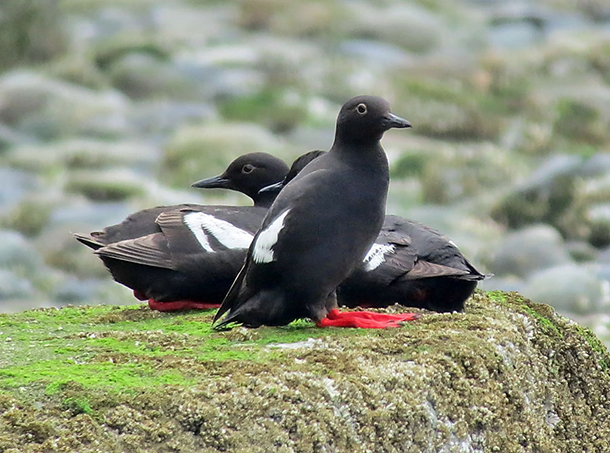
Pigeon Guillemot (Photo: Mike Hamilton)
###
Written by Bob Sundstrom
Bird sounds provided by The Macaulay Library of Natural Sounds at the Cornell Lab of Ornithology, Ithaca, New York. Olive sided Flycatcher [95787] recorded by Bob McGuire; Eastern Wood-Peewee [191222] recorded by Wilbur L Hershberger; Northern Saw-whet Owl [130470] recorded by Gregory F Budney; Pigeon Guillemot recorded by Geoffrey A Keller and Gerrit Vyn, featured on the CD 'Bird Songs of the Pacific Northwest' Disk 2 Track 53, Macaulay Library, Cornell Lab of Ornithology, Ithaca, New York.
Surf sound '#23 Surf Moderate' from Nature SFX, recorded by Gordon Hempton, of QuietPlanet.com
BirdNote's theme music was composed and played by Nancy Rumbel and John Kessler.
Producer: John Kessler
Executive Producer: Dominic Black
© 2015/2017 Tune In to Nature.org January 2015/2017 Narrator: Michael Stein
http://birdnote.org/show/birds-whistle
BACALL: You know how to whistle, don’t you Steve? You just put your lips together…and blow… [SOUNDTRACK, “TO HAVE AND HAVE NOT”
[MUSIC: Ronnie Ronalde, “In a Monastery Garden” on Route 86, Albert William Ketelby, Columbia Records]
CURWOOD: And if you like it, you can whistle on over to our website for some pictures.
Related links:
- Listen on the BirdNote website
- About the Olive-Sided Flycatcher
- About the Eastern-wood Pewee
- About the Northern Saw-whet Owl
- About the Pigeon Guillemot
[MUSIC: Ronnie Ronalde, “In a Monastery Garden” on Route 86, Albert William Ketelby, Columbia Records]
CURWOOD: Coming up...the loss of a grandmother underscores ecosystem troubles in the waters off Seattle. That’s just ahead here on Living on Earth. Stay tuned.
ANNOUNCER: Funding for Living on Earth comes from you our listeners, and United Technologies - combining passion for science with engineering to create solutions designed for sustainability in the aerospace, food refrigeration and building industries. UTC companies such as Otis, Carrier, Pratt & Whitney and UTC Aerospace Systems are helping to move the world forward.
This is PRI, Public Radio International.
[CUTAWAY MUSIC: Darol Anger featuring The Nashville Lumberyard, “John Henry” on Diary of a Fiddler, Compass Records.]
Missing Granny the Whale
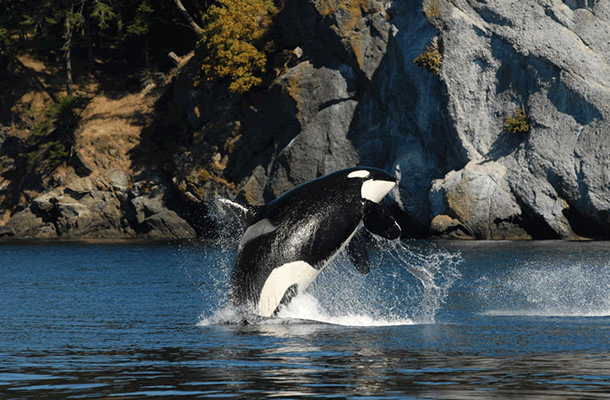
J2, also known as “Granny”, may have been as old as 105 at her death. (Photo: Center for Whale Research)
CURWOOD: It’s Living on Earth, I’m Steve Curwood. Orcas, or Killer whales are the largest of the dolphin family, and two of the most famous of these whales recently died. Tilikum of SeaWorld starred in the documentary Black Fish and became a poster-creature for the problems of confining Orcas in tanks to perform for audiences. And, by the way, other Orcas at Sea World in San Diego will no longer perform, though they will still live at the park.
And in Puget Sound off Seattle a wild Orca nicknamed “Granny”, is presumed dead, and she may have been 105 years old. Researchers knew her as J2 and say she was the oldest known killer whale until she went missing about three months ago. Ken Balcomb will miss this matriarch cetacean more than most.
He’s studied J2 and her orca family since the 1970s. He also founded the Center for Whale Research in Friday Harbor, where he is now the Executive Director. Ken, welcome to Living on Earth.
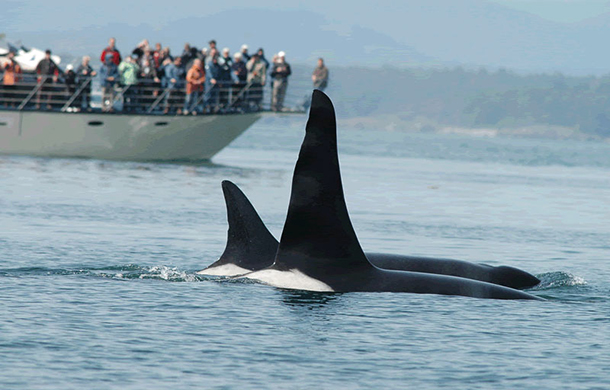
J2 on the left with her son, J1. Adult male orcas have a distinctively tall, straight dorsal fin, compared with the shorter curved dorsal of a female. (Photo: Center for Whale Research)
BALCOMB: Well, thank you for having me.
CURWOOD: And I'm so sorry to hear about the loss of this majestic creature.
BALCOMB: It's a blow to us all. She was an icon of not only her pod and the population, but of the northwest.
CURWOOD: So, how sure are you that she's really gone? Maybe she's on a walkabout someplace? You know, there's a big ocean out there.
BALCOMB: Yeah, we wish. We've crossed our fingers for three months, but when we have a half a dozen encounters with the family, and the individual we seek is not there, they're presumed deceased, and then by the next year we're confirmed deceased. She's gone. We know it. Her time was up.
CURWOOD: And she wouldn't have left her family.
BALCOMB: No, no, that's one thing they don't do. All the whales stay together in a family group throughout their life.
CURWOOD: Ken, you've been studying J2 for decades. Tell us what it's been like to watch her in the waters there of Puget Sound.
BALCOMB: Well, it's been amazing. When we began the study in 1976, we were following in the giant footsteps of Dr. Mike Bigg, who started at the north end of Vancouver Island, found a pod of whales, called them “A” pod and numbered them within the group A1,2,3 and B and C and D and so on as he came down the island. When he came to the south end adjoining Puget Sound, he was at J, K and L in the alphabet and that's where we've been. One of the whales that was adult, she was leading the pod, and that was J2, Granny.
CURWOOD: So, tell me about her group. There are different pods, of course, with these whales.
BALCOMB: Well, I first saw Granny in 1976 on April 16. The pod was spread out coming into Puget Sound through Admiralty Inlet. I had previously seen K and L pods out in the Strait of Juan de Fuca, and I called up Dr. Bigg and excitedly told him, "Hey, we found a new group of whales." And he dampened my excitement right away by saying, "Oh, you must have found J pod," and he started describing every whale in the pod over the phone to me, while I was looking at the pictures that I took, and it was precise. We had this female that was always accompanying this very tall fin male that had a wavy back margin to his fin. He was called J1, and she was the one that was always right next to him. She had a little nick in her fin, and she was J2. After years of study, we surmised, based upon from what we saw from the other whales, that she was his mother because we have observed now that the offspring never leave their mother in their lifetime.
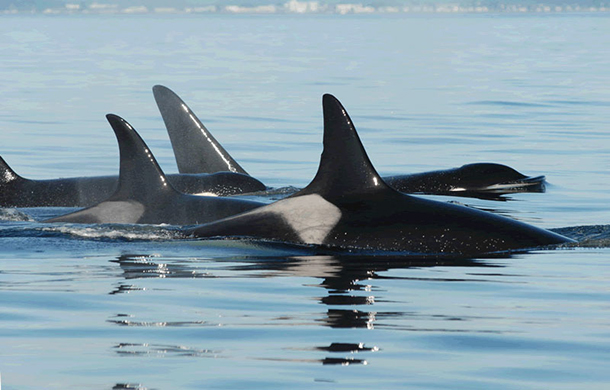
J2 with her pod in 2011 (Photo: Center for Whale Research)
CURWOOD: How did researchers know approximately how old J2, Granny might have been?
BALCOMB: Well, we took the estimated birth date of J1 as 1951, based upon photographs that we had of him already mature in 1967 captures. See, all these whales in the southern resident killer whale community had been captured numerous times, from the early or mid-1960s to the mid-1970s, and the babies had been removed each time and sold to aquaria throughout the world. So, we had two things going on. We had photographs of what were adults and uwere nsuitable for transport, and we had a whole cohort age of young whales that were removed. So, we had a skewed population structure when we began the study in 1976.
Anyway, back to J1, birthdate '51, and at the time no other relatives that could be identified as being subsequent babies of Grandma, so we then made the assumption that he was her last offspring. In which case, females like female humans have a menopause at about age 40 they stop reproducing, but they'll still have a long post reproductive life, babysitting, leading, teaching the other whales what they've learned in their lifetime. At least she was born before 1941 and probably 1911.
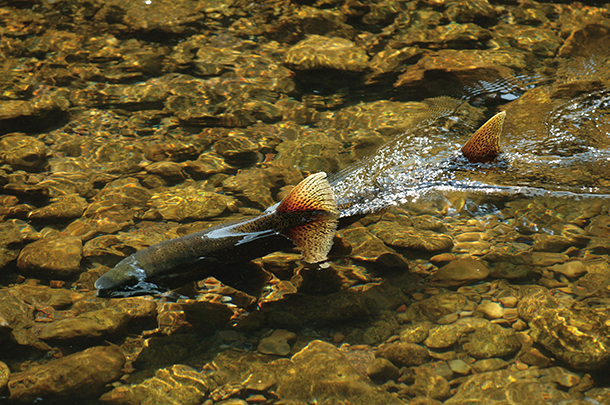
Chinook salmon, a key prey of southern resident killer whales, returning to their spawning grounds (Photo: Lynn Ketchum / Oregon State University, Flickr CC BY-SA 2.0)
CURWOOD: So, do a little math here. If she was born in 1911, she died 105 years later. So, Granny would've seen the whole change in the oceans in her lifetime and experienced a fair amount of heartbreak if she was captured repeatedly and the children were taken away.
BALCOMB: Yeah, if she could tell us the story of her life, people should listen very carefully. She's seen, basically, a marine ecosystem degraded to the point where now it's threatening the entire population. It's threatening the life of the ocean, really.
CURWOOD: You say that this pod of killer whales is an urban pod. Why do you say that?
BALCOMB: Well, these whales come into what we call the Salish Sea. We now call it Salish Sea, but it was previously called Puget Sound and the Strait of Juan de Fuca and Georgia Strait, the inland waters of Washington and southern British Columbia. And there were, at the time we began this study, about 1.9 million Chinook salmon caught in this area, averaged well over 20 pounds each year by humans. So, there are a lot of fish around here, and they came here for the fish. The whales came for the fish, and they in fact had specialized on these fish for most of their recent evolution since the Ice Ages. They didn't come to see the people or the Seattle Space Needle or the mountains around here. They came to eat the fish year-round, but as the fish populations declined due to over-harvest, damming of the rivers, logging practices, and development of the shorelines that were areas that fish required for their growth and feeding before they headed to the big ocean for three or four years before coming back to spawn, dams were the big killer. Once the dams were put in on the rivers, the fish couldn't return to the river to spawn, and we've seen, I mean right now, 22,000 King Salmon compared to 1.9 million is a more than quantum decrease.
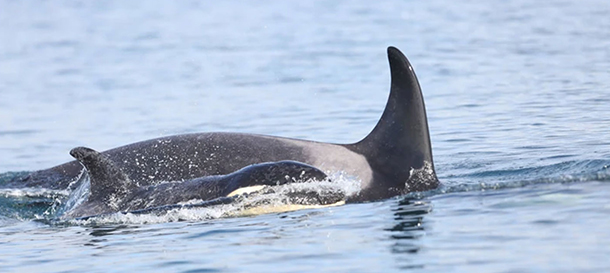
On October 23rd, 2016 whale observers Mark and Hanna Malleson received a report that ten-month-old orca calf J54 looked to be in poor condition, with “raked up and peeling” skin and “a major depression behind his blowhole”. Days later researchers announced his mother had probably died. Above, fellow pod member J46 supports the ailing J54. (Photo: Mark Malleson)
CURWOOD: So, what was Granny's role, what was J2’s role in her pod and in the broader population of the southern resident Killer whales?
BALCOMB: She learned from her mom and grandma what rivers and what seasons had returning biomasses of Chinook salmon. And so, they would go around...It's like berry-picking season, go around to every area that had abundant fish supplies. She had to know where these spots were, and she taught all of her offspring and the others in the pod, “Well let's go over there.” She’d be the leader.
CURWOOD: So, what do you think is going to happen now to this J pod, now that Granny’s gone?
BALCOMB: Well, we've already seen it happen in other pods. The K and L pods, they've lost matriarchs, older females, and we get a fragmentation of the social structure. Now they're traveling in just their little family groups, you know, five or six whales. When you have a few thousand fish over tens of thousands of square miles of ocean, you have to be in small hunting groups to find anything. You can't all be in one place. So, we see this fragmentation as a result of prey resource depletion and social fragmentation. Basically, your leader is gone. Now what do you do? She had daughters...well, actually her daughter has died and her son has died, but her granddaughter is still alive. They are the presumed next leaders, but the problem has been that, first of all, we removed a whole cohort of whales that should have grown up and been leaders now, and we're experiencing food resource problems that is making… the miscarriage rate of these whales, on the order of 75 percent of the conceptions miscarry. They're aborted. It leads us to a conclusion that there is an issue in reproduction here, a real problem.

Whale watchers at Haro Strait, late August 2016 (Photo: Ken Balcomb)
CURWOOD: So, what's your best guess as to why the Orcas are losing baby whales. We're talking about pollution? We're talking about the lack of salmon? What's going on here?
BALCOMB: Granny was born before any of these industrial contaminants, pollutants that bioaccumulate in the tissues, were even developed, and we've subsequently found that a lot of these things like PCPs, PBDEs, DDTs, affect life functions, and a lot of them are hormone mimics. They're you know like, “Little fetus start growing a fin or you start breathing now or developing a nervous system or reproductive system.” What is going on is you have these whales going along eating contaminated food, metabolizing the energy in that food and storing it in their blubber fat. As long as there's lots of fish, they're only getting the contamination that's available in that fish that they eat right now, but when they don't have fish they go back to this blubber layer and metabolize that fat which has accumulated over thousands and thousands of fish, to the point where it's hyper-toxic.
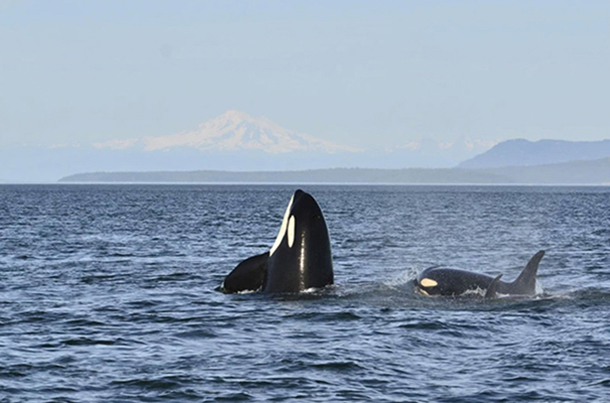
Another member of the J pod, J22, “spy hops” in front of Mt. Baker in Haro Strait (Photo: Jeff Hogan)
We know that if humans were exposed to those levels of toxins, they would have birth defects, birthing issues in general, measurable decrease in brain size and in brain function, measurable decrease in reproductive function even to the point of zero reproductive abilities. You know, we see it in people. We see it in mice. We see it in seals. And we see it in whales. It affects them, and it affects their offspring.
We have about 10 more years of reproductive viability in this population to turn around the issue of whether or not we're going to feed them, and whether or not we're going to feed them is dependent upon, are we going to do something about big obstacles to fish reproduction like the dams. If the fish can't swim up the river to spawn, we're not going to have fish in the future.
CURWOOD: So, Ken, one of the things you first notice when you go to your website, the Center for Whale Research, are all the whale obituaries. It looks like the J pod of Orcas in Puget Sound lost several family members in just the past few months. What you think is going on?

Granny (J2) breaching, or leaping out of the water, in 1998 (Photo: Center for Whale Research)
BALCOMB: Well, yeah, they've lost five individuals here in the past few months, and they were not only the leader individual but two of the reproductive mothers and their offspring. What do I think is going on? I think we're seeing the end of the tunnel here.
We've been complaining for years to the government and trying to educate the public about the need to feed these whales. And the least expensive and most available food would be wild Chinook salmon that were allowed to return to the rivers and spawn and produce food for humans, whales, the whole ecosystem. The dams that are in question are on the Columbia River, which used to provide 12 million Chinook salmon a year, and then that production was stopped by damming the rivers and there are four of them right now on the Snake River system that deny access to what had been a million to two million adult Chinook a year coming up to spawn.
CURWOOD: So, you worked with Granny, J2, for some four decades. How do you feel about her loss?
BALCOMB: I couldn't talk about it for a couple days. You're the first person I've talked to about this since we've made our announcement. I've had several people in media plead with me to get on there and say it like it is. It really hurt.
What is actually distressing me more right now is that her loss may be irrelevant to our human society. I mean, we will have a little emotional tag to it, but we didn't as a society accept the factual observations. Truth is almost irrelevant. Observed facts are almost irrelevant. You get elected or make money or you do whatever on the basis of your tweets and Twitters and unverifiable facts. If you can sway this thing this way, you do, if it is to your benefit. I thought that science and basic observable facts were going to be important, and that's pretty distressing for me to see, along with the passing of Granny, to see that that's what we're going to have to deal with in the future. We're in a bind here, if we're not to pay attention to observed facts. They were the top of a very, very productive ecosystem that we're seeing go away before our very eyes, and if we don't look at these “canaries in our coal mine”, then we're playing stupid.
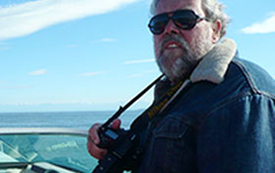
Ken Balcomb has been studying Granny (J2) for more than four decades (Photo: Center for Whale Research)
CURWOOD: You say that these Orcas really live with their families forever. To what extent do you think they love each other, care about each other?
BALCOMB: To a great extent. The scientists will give it a term called epimeletic behavior or caregiving. They will carry a dead infant on their back for a week. Or they will assist an injured podmate, support it and two whales will be on either side of it and hold it up so it can breathe. They're obligated to keep moving. It's like the Marines, you know? You don't leave them behind, you carry them with you. Ultimately, you have to let them go, like we'll have to let Granny go, and like she's let many others go in her lifetime.
CURWOOD: Ken Balcomb is the Executive Director and Senior Scientist of the Center for Whale Research in Friday Harbor, that's in Puget Sound, Washington. Thanks so much, Sir, for taking the time with us today.
BALCOMB: Thank you. It's been my pleasure.
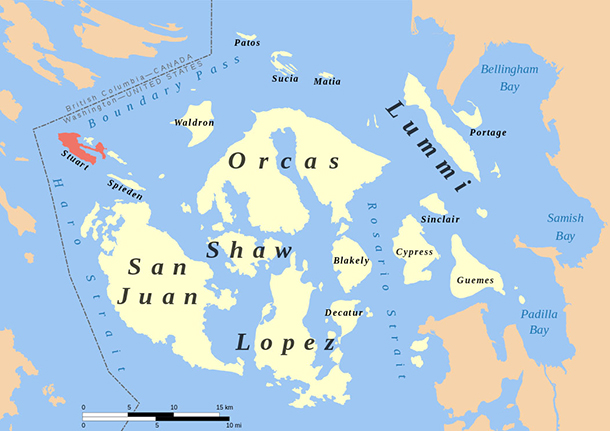
Ken Balcomb recorded sounds of orcas off the coast of Stuart Island (shown in red above) in the Salish Sea in 1995. (Photo: Evan Derickson, Wikimedia Commons CC BY-SA 4.0)
[MUSIC: Noah and The Whale “Instrumental II” from The First Days of Spring, 2009 Mercury Record]
[ORCAS CALLING]
CURWOOD: We leave you this week among those very Orcas in Puget Sound.
[ORCAS CHATTERING AND CALLING]
At about 11 p.m. one night in 1995, Ken Balcomb came across J, K and L pods gathered together south of Stuart Island.
[ORCA CHATTER]
Ken writes that there were plenty of salmon, and the gathering seemed very social with whales chattering to each other, as if they were having a party.
[ORCAS CALLING]
In the pitch darkness, he recorded this with a hydrophone, as some 98 whales blew and spouted around his boat.
[ORCAS CALLING]
Related links:
- “J2: In Memoriam”, by Ken Balcomb
- “Goodbye Granny,” by Erin Heydenreich of the Center for Whale Research
- About Orcas
- Threats to Orcas
- Seattle Times: “Sad drama in Puget Sound: Another orca dies, dim hopes for her calf”
- Video of J and L pods breaching in the waters off British Columbia
- New study provides one theory for why orcas go through menopause
[MUSIC: Paul Winter and Friends, “"Lullaby From The Great Mother Whale For The Baby Seal Pups” on Concert For the Earth, Paul Winter/Roger Payne, Living Music]
CURWOOD: Living on Earth is produced by the World Media Foundation. Our crew includes Naomi Arenberg, Bobby Bascomb, Savannah Christiansen, Jenni Doering, Jaime Kaiser, Don Lyman, Alex Metzger, Helen Palmer, Adelaide Chen, and Jolanda Omari. We welcome a new intern today, Noble Ingram. We’re happy to have you aboard. Tom Tiger engineered our show, with help from John Jessoe, Jake Rego and Noel Flatt. Alison Lirish Dean composed our themes. You can hear us anytime at LOE.org - and like us, please, on our Facebook page - PRI’s Living on Earth. And we tweet from @LivingOnEarth. I'm Steve Curwood. Thanks for listening.
ANNOUNCER1: Funding for Living on Earth comes you, our listeners, and from the University of Massachusetts, Boston, in association with its School for the Environment, developing the next generation of environmental leaders. And from the Grantham Foundation for the protection of the environment, supporting strategic communications and collaboration in solving the world’s most pressing environmental problems. Support also comes from the Energy Foundation, serving the public interest by helping to build a strong, clean energy economy, from Gilman Ordway, and from SolarCity, America’s solar power provider. SolarCity is dedicated to revolutionizing the way energy is delivered by giving customers a renewable alternative to fossil fuels. Information at 888-997-1703. That’s 888-997-1703.
ANNOUNCER2: PRI. Public Radio International.
Living on Earth wants to hear from you!
Living on Earth
62 Calef Highway, Suite 212
Lee, NH 03861
Telephone: 617-287-4121
E-mail: comments@loe.org
Newsletter [Click here]
Donate to Living on Earth!
Living on Earth is an independent media program and relies entirely on contributions from listeners and institutions supporting public service. Please donate now to preserve an independent environmental voice.
NewsletterLiving on Earth offers a weekly delivery of the show's rundown to your mailbox. Sign up for our newsletter today!
 Sailors For The Sea: Be the change you want to sea.
Sailors For The Sea: Be the change you want to sea.
 The Grantham Foundation for the Protection of the Environment: Committed to protecting and improving the health of the global environment.
The Grantham Foundation for the Protection of the Environment: Committed to protecting and improving the health of the global environment.
 Contribute to Living on Earth and receive, as our gift to you, an archival print of one of Mark Seth Lender's extraordinary wildlife photographs. Follow the link to see Mark's current collection of photographs.
Contribute to Living on Earth and receive, as our gift to you, an archival print of one of Mark Seth Lender's extraordinary wildlife photographs. Follow the link to see Mark's current collection of photographs.
 Buy a signed copy of Mark Seth Lender's book Smeagull the Seagull & support Living on Earth
Buy a signed copy of Mark Seth Lender's book Smeagull the Seagull & support Living on Earth

